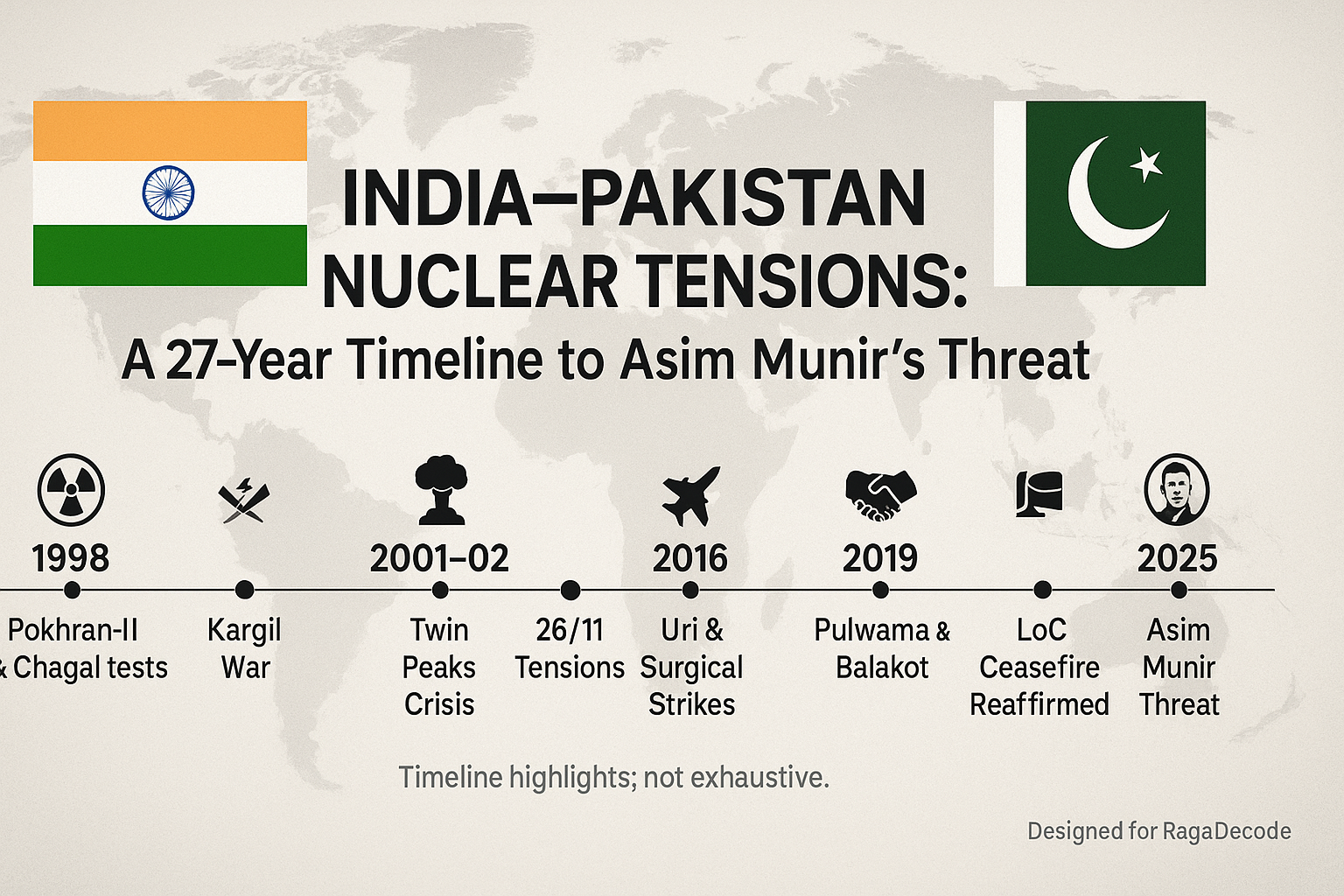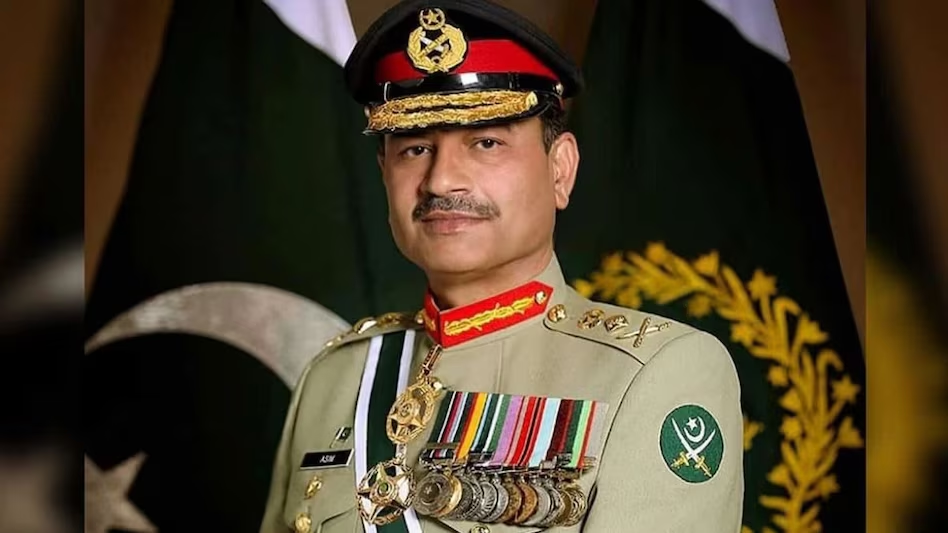1998 Nuclear Age Begins
- Both India and Pakistan conduct nuclear weapons tests in May 1998
- Officially declare themselves nuclear-armed states
- Change in regional and global security calculus
In May 1998, India carried out a series of underground nuclear tests in Pokhran, swiftly followed by Pakistan’s own tests in Chagai. This transformed South Asia into the world’s newest nuclear flashpoint. Both countries framed the tests as defensive moves, yet they also introduced a volatile new dynamic: any future war could now escalate to a nuclear exchange. The tests triggered global sanctions, but also shifted deterrence logic in the region. Pakistan adopted an explicit first-use posture to counter India’s conventional superiority, while India announced a “No First Use” policy. Since then, both nations have built arsenals of over 150 warheads each, with delivery systems ranging from aircraft to ballistic missiles.
1999 Kargil Conflict
- Pakistan-backed forces infiltrate Indian positions in Kargil, Kashmir
- India launches a military operation to push them back
- Nuclear backdrop deters full-scale war
Barely a year after the nuclear tests, India and Pakistan fought a limited but intense war in the mountains of Kargil. Pakistani forces, supported by its military, occupied strategic heights on the Indian side of the Line of Control. India responded with large-scale conventional attacks, supported by air power. The presence of nuclear weapons on both sides was a shadow over every military move. Pakistan hinted at escalation if India crossed certain red lines, and Western powers intervened diplomatically to prevent a wider war. The Kargil conflict demonstrated a dangerous pattern: Pakistan believed its nuclear arsenal could shield it from Indian retaliation while supporting cross-border operations. India, however, showed it would still use military force despite nuclear risks.
2001–2002 Twin Peaks Standoff
- Terror attack on Indian Parliament sparks mass troop mobilization
- Ten-month military standoff along the border
- Pakistan signals nuclear readiness
In December 2001, a deadly terror attack on India’s Parliament led to “Operation Parakram” the largest military mobilization in India since the 1971 war. Over half a million soldiers massed along the India–Pakistan border. Pakistan responded with its own mobilization and overt nuclear signaling, including missile tests and publicized movements of nuclear-capable assets. The standoff lasted nearly a year, earning the nickname “Twin Peaks” for its two periods of heightened tension. Although war was narrowly avoided, the crisis entrenched Pakistan’s belief that nuclear threats could deter India’s conventional might. For India, the episode revealed the need for quicker strike options — leading to later doctrines like “Cold Start” for rapid mobilization and limited objective attacks.
2008 Mumbai Terror Attacks
- Pakistan-based militants kill over 170 in Mumbai
- Global outrage but no Indian military strike
- India focuses on diplomatic and covert responses
The November 2008 Mumbai terror attacks a coordinated assault by Pakistan-based Lashkar-e-Taiba operatives shocked the world. Over three days, gunmen targeted hotels, a train station, and a Jewish center, killing more than 170 people, including foreigners. India faced immense public pressure to retaliate militarily but refrained from open strikes, partly due to the risk of nuclear escalation and international calls for restraint. Instead, India intensified intelligence operations and diplomatic efforts to isolate Pakistan. This moment underscored a strategic dilemma: Pakistan’s nuclear shield emboldened militant activity, while India sought alternative forms of retaliation short of war.
2016 Uri Attack and Surgical Strikes
- Militants attack an Indian army camp in Uri, killing 19 soldiers
- India conducts cross-border “surgical strikes”
- Pakistan denies the strikes occurred
In September 2016, four heavily armed militants attacked an Indian Army brigade headquarters in Uri, Jammu & Kashmir. India blamed Pakistan-based groups and retaliated within days by launching what it called “surgical strikes” across the Line of Control. The operation reportedly targeted terrorist launch pads and inflicted significant casualties. Pakistan denied the strikes, but India’s public announcement marked a shift New Delhi demonstrated willingness to cross the LoC militarily without triggering full-scale war. This was viewed as a test of Pakistan’s nuclear bluff: limited, targeted operations could be carried out without triggering nuclear escalation, provided they avoided deep incursions into Pakistani territory.
2019 Pulwama and Balakot
- Suicide bombing in Pulwama kills 40 Indian paramilitary soldiers
- India strikes Balakot in Pakistan’s Khyber Pakhtunkhwa province
- Pakistan responds with air combat over Kashmir
February 2019 saw one of the deadliest terror attacks in Kashmir’s history when a suicide bomber from Pakistan-based Jaish-e-Mohammed killed 40 Indian paramilitary soldiers in Pulwama. India responded with an unprecedented airstrike in Balakot, deep inside Pakistan’s territory, claiming to hit a terrorist training camp. Pakistan retaliated with airstrikes across the Line of Control, leading to a rare aerial dogfight. Both nations put their militaries on alert, and nuclear rhetoric flared. This crisis marked a turning point: India showed it was willing to cross deep into Pakistani territory despite nuclear threats, while Pakistan demonstrated it would respond militarily, increasing the risk of escalation.
2025 April Pahalgam Terror Attack
- Large-scale terror strike in Jammu & Kashmir
- India blames Pakistan-based militants
- Tensions spike amid calls for retaliation
In April 2025, militants carried out a major attack in Pahalgam, Jammu & Kashmir, killing dozens. The incident bore resemblance to the 2019 Pulwama attack in scale and method. India swiftly accused Pakistan-based terrorist networks of orchestrating the strike, while Islamabad denied involvement. Public outrage in India demanded a strong military response, and political pressure on New Delhi to act decisively mounted. The attack came amid already strained relations, with both sides modernizing their nuclear arsenals. This set the stage for one of the most serious India–Pakistan crises in decades.
2025 May Operation Sindhur
- India launches deep cross-border strikes into Pakistan
- Targets military and militant infrastructure
- Pakistan elevates Asim Munir to Field Marshal
In May 2025, India conducted “Operation Sindhur,” a set of deep strikes into Pakistani territory targeting military installations and terror infrastructure. This was one of India’s most far-reaching operations in years, showcasing advanced precision strike capabilities. Pakistan responded politically and symbolically by promoting its Army Chief, Asim Munir, to the rare rank of Field Marshal signaling military dominance in national decision-making. The move also served as a message of defiance to both India and the international community. The crisis deepened, with fears of miscalculation growing.
2025 August Munir’s Threat from U.S. Soil
- Munir threatens to “take half the world down” if Pakistan faces an existential threat
- Targets mentioned include Indian dams and key infrastructure
- India condemns the remarks as “nuclear blackmail”
At a private Pakistani diaspora event in the United States, Field Marshal Asim Munir issued an unprecedented threat: if Pakistan faced an “existential threat” from India, it would “take half the world down” with nuclear weapons. He also referenced specific Indian infrastructure and even named prominent business leaders as potential targets. The fact that this statement was made on U.S. soil a country seen as a friend to both nations added a diplomatic shockwave. India’s government condemned the remarks as reckless and dangerous, while the U.S. maintained public silence. The statement’s global framing implying a threat beyond South Asia elevated the stakes from a regional standoff to a potential international security crisis.



